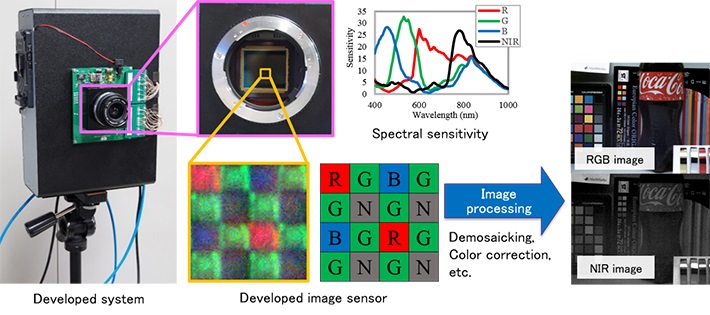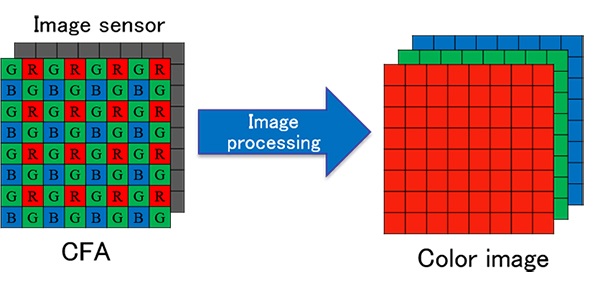June 3, 2016
Masatoshi Okutomi and researchers at Tokyo Tech and Olympus R&D have developed a new imaging system for simultaneous acquisition of color (RGB) and near-infrared (NIR) images using only a single image sensor.
Commercially available compact and low-cost color digital cameras acquire single-sensor color images with a color filter array (CFA)— an array of R, G, and B filters and overlaid on the image sensor (Fig. 1). Therefore, the data acquired by CFA based image sensors are mosaic. A set of image processing algorithms such as an interpolation process of the mosaic data called demosaicking, and color correction is performed to acquire a full-color image. In this way, current color cameras realize low-cost and easy-to-use color image acquisition.
In recent years, many applications using a pair of color (RGB) and near-infrared (NIR) images have been proposed by computer vision and image processing communities. With this background, the group of Masatoshi Okutomi at Tokyo Tech and researchers at Olympus R&D have developed a prototype of a new imaging system for the simultaneous acquisition of RGB and NIR images using a single image sensor. Figure 2 is an overview of a prototype of this system consisting of a novel CFA that contains both RGB and NIR filters. The arrangement of the new CFA is shown in the Fig. 2, where "N" represents the NIR filter. The researchers have also developed an image processing system that can execute sets of image processing algorithms, such as demosaicking and color correction, in real time. The new system can acquire and display high-quality RGB and NIR images simultaneously at 60 frames per second (fps). Since the new system can provide users with a practical solution for simultaneous acquiring both the RGB and the NIR images, it is expected to open up a new range of applications in many fields such as remote sensing, security, robotics, agriculture, and medical imaging, where the NIR information is useful.

Figure 2. Overview of the developed prototype system.
About Tokyo Institute of Technology
Tokyo Institute of Technology stands at the forefront of research and higher education as the leading university for science and technology in Japan. Tokyo Tech researchers excel in a variety of fields, such as material science, biology, computer science and physics. Founded in 1881, Tokyo Tech has grown to host 10,000 undergraduate and graduate students who become principled leaders of their fields and some of the most sought-after scientists and engineers at top companies. Embodying the Japanese philosophy of “monotsukuri,” meaning technical ingenuity and innovation, the Tokyo Tech community strives to make significant contributions to society through high-impact research.
This research was partly supported by the MIC/SCOPE #141203024 funding.
Website:
http://www.titech.ac.jp/english/
Reference 1
Authors:
Kazunori Yoshizaki, Munenori Fukunishi, Yasuhiro Komiya, Yusuke Monno, Masayuki Tanaka, Masatoshi Okutomi and Steven Lansel
Title of original paper:
"A Real-Time RGB-NIR Imaging System Using a Single Image Sensor"
Conference:
IEEE Conference on Computer Vision and Pattern Recognition (CVPR2016)(Demonstration, June 2016)
Reference 2
Authors:
Hayato Teranaka, Yusuke Monno, Masayuki Tanaka and Masatoshi Okutomi
Title of original paper:
"Single-Sensor RGB and NIR Image Acquisition: Toward Optimal Performance by Taking Account of CFA Pattern, Demosaicking, and Color Correction"
Conference:
IS&T International Symposium on Electronic Imaging (EI2016), February, 2016.













